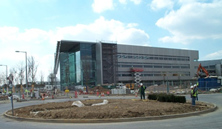Any development change will normally have an impact on transport in the local area due to change of use and/or size of development. The national planning policy guidance document on transport, NPPF, states that a Transport Assessment (TA) is required as part of a planning application where the development has significant transport implications. The requirements depend on certain thresholds set by planning authorities. A TA or for smaller developments a Transport Statement (TS) will assess the transport impact on the surrounding network.
In recent years in relation to sustainable issues a TA will not only assess the vehicular impact, but that of all modes including walking, cycling and public transport. Planning authority requirements are that developments are accessible by all modes of transport, gone are the ideas of out of town shopping centres that are only accessible by car.
PTC has experience in preparing TA’s for a wide variety of developments in the UK that covers, mixed use, retail, educational, industrial, business, residential and leisure developments. The aim of the TA is to set out and consider the transport impact, set out proposals to minimise the impact and promote sustainable transport solutions.
The majority of highway authorities have adopted the Department for Transport (DfT) “Guidance on Transport Assessments” (May 2007) or for strategic schemes in London the Transport for London (TfL) “Transport Assessment best practice” (April 2010) that sets out the requirements of a TA. It is important that discussions are held with the highway authority early in the planning so that specific requirements are scoped for each proposed development. Below is a summary of the possible requirements.
Base Conditions
This may describe the location, brief site history, layout, site uses and access. Also included will be the existing transport network including main traffic routes, walking and cycling routes and public transport provision.
Proposed Development
This may provide details of the proposed development, including a breakdown of the proposed land-uses, site access proposals and any proposed modifications to the existing highway. It may also discuss parking, public transport, pedestrians and cyclists proposals. PTC is able to advise the developer on highway and access layouts and have experience in working with architects throughout the master-planning process to develop scheme layouts that meet current highway requirements. PTC is also skilled in developing parking requirements including parking numbers and layouts and designing space for deliveries and servicing. PTC has also in house capabilities to design new junctions, footways and crossing points that may be required for the proposals.


Trip Generation
This will include an assessment of the existing and anticipated trips associated with the development that could include cars, deliveries, people, cyclists, public transport users. Relevant database software is available such as TRICS and TRAVL that contains previous site survey data of similar developments taking account of land use, size, location, parking and accessibility. The PTAL (Public Transport Accessibility Level) will need to be calculated for developments in London based on proximity and frequency of rail and bus services. Transport counts maybe required for existing developments still in use or for proposed developments that have no existing comparable data.
Distribution and Forecasting
Generated trips will be required to be distributed onto the transport network. PTC has developed specialist techniques using Census Origin and Destination data to predict travel distribution on the network. Some authorities will require a prediction of future background traffic flows due to increases in housing and employment growth using forecasting software such as TEMPRO.
Highway and Junction Capacity Assessment
The impact on the surrounding highway network will need to be assessed due to the change in the number of trips associated with the proposed development. This element will depend on the level of impact and if a TA or TS is required for the planning application. PTC are skilled in modelling impacts using junction modelling software such as PICADY for priority junctions, ARCADY for roundabouts and LINSIG for signalised junctions. It may not only be vehicles that need to be assessed, a multi modal assessment may be required for pedestrian and public transport users.
Pelham Transport Consulting, 3 Mill Hill Drive, Shoreham-by-se, West Sussex BN43 5TJ